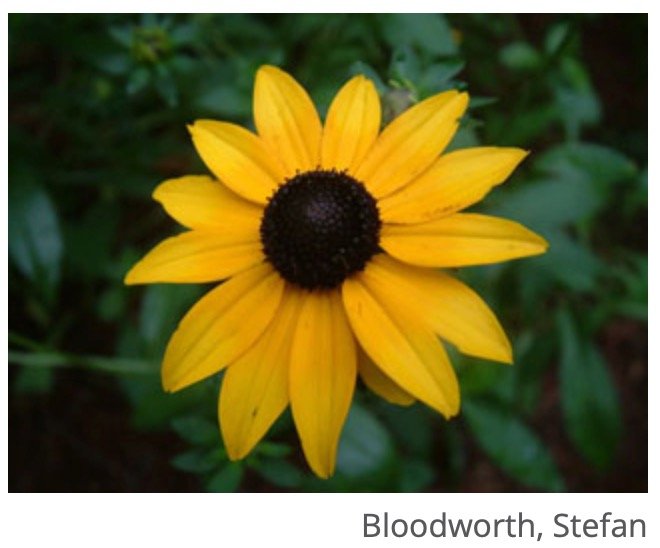Get ready for a wild mix of color and function! The powerhouse plants of the Short Street Nature Preserve — all native to our local ecosystem — have been planted in strategic locations around the site.
Plants Featured on Nature Preserve Signs
If you are at the site and looking at our “seek and find” signs, you should be able to find these featured plants:

Butterfly Weed (Asclepias Tuberosa)
This host plant for monarch butterfly caterpillars features clusters of yellow to bright orange flowers to create a haven for monarchs, queen butterflies, and other critical wildlife species. The compact shrub-like structure is ideal for urban or suburban yards and large containers. It thrives in full sun to light shade and is drought-tolerant once established. It normally blooms from late June through August and reproduces primarily through seed dispersal.
It also supports other wildlife species including birds, other butterflies, moths, and bees; returns each year; never needs chemicals; should not require watering once established; and is deer resistant when mature.
You can purchase non-GMO plants at https://gardenforwildlife.com/products/orange-butterfly-milkweed-3-pack.

Baby Joe Pye Weed (Eupatorium Dubium)
Joe Pye Weed is a native perennial wildflower that normally flowers July – October. Joe-Pye Weed does best in moist to wet soil conditions, like swamps, bogs, marshes, and swales. It thrives in full sun to partial shade, with more robust blooms occurring in ample sunlight.
Joe Pye Weed reproduces by seed. Joe Pye Weed supports butterflies, songbirds, and beneficial insects, including bees and the swallowtail butterfly.

Great Blue Lobelia (Lobelia Siphilitica)
In the late summer and early fall, Great Blue Lobelia adds striking blue flowers that support a variety of pollinators. Hummingbirds are attracted to the nectar of this majestic plant.
The Great Blue Lobelia thrives in full sun to partial shade and moist soils. These plants are medium to large perennials that work well in meadows, near streams and ponds, and in pollinator gardens, butterfly gardens, native gardens, and rain gardens. https://mortonarb.org/plant-and-protect/trees-and-plants/great-blue-lobelia/. This plant spreads primarily through seeds and rhizomes.

Soft Rush (Juncus Effusus)
This native marsh plant, with soft, grass-like stems, grows in clumps, and each bears clusters of very small, greenish-brown, scaly flowers (with the clusters diverging from one point on the side of the stalk near the top). This rush can tolerate a wide range of sunlight conditions and prefers moist to wet soils or water. Soft Rush reproduces both via seeds and rhizomes. Muskrats feed on the rootstalks, and birds find shelter among the stems. (www.wildlife.org)

Tussock Sedge (Carex Stricta)
Carex stricta is a vigorous sedge that forms numerous leafy culms from underground rhizomes. Plants form tussocks or mounded clumps that sit slightly above the water level. Carex stricta is valuable for erosion control. This sedge can be used to reduce maintenance and hold ground on various shorelines. Plants are dear resistant.
Try pairing plants with Asclepias incarnata, Aster puniceus, Iris versicolor, Iris virginica, Juncus effusus and Scirpus cyperinus.
Carex stricta hosts caterpillars of Appalachian Brown and Eyed Brown Butterflies along with several species of Skippers and moths. Wetland birds and turtles feed on the seed. Dense colonies provide excellent cover for birds and other wildlife. The Sedge Wren feeds and nests in sites dominated by wetland sedges (information provided here is from: http://www.newmoonnursery.com/plant/Carex-stricta)

Sweet Pepperbush (Clethra Alnifolia)
Sweet Pepperbush is a narrow, 6-12 ft., deciduous shrub that often spreads into mounded clumps. A tall, many-branched, leafy shrub with upright clusters of fragrant white flowers. The shrub has erect, multiple stems; exfoliating bark; and simple, oval, toothed leaves which turn yellow to orange in fall. White flowers peak in mid-summer and are followed by brown capsules which persist through winter. It thrives in full to partial sun, prefers moist to wet soil, and reproduces primarily by seed. This shrub forms sizable patches and is generally free of any disease, insect, or physiological problems. Its dry fruiting capsules remain long after flowering and help identify this plant in winter. https://www.wildflower.org/plants/result.php?id_plant=CLAL3

Virginia Sweetspire (Itea Virginica)
An upright, arching to rounded deciduous to semi-evergreen shrub. Fragrant white bottebrush flowers appear in early to midsummer when few other shrubs are blooming. This highly adaptable shrub can tolerate flooding, dry sites, periodic drought compaction, and salt — though it prefers moist to wet soils. It also thrives in a variety of sunlight conditions, ranging from full sun to partial shade. Reproduction occurs through mechanical dispersal of post-flowering seeds and through rhizomes. This plant is also a valuable nectar source for pollinators.

Mountain Mint (Pycnanthemum Virginianum)
Virginia Mountain-mint is a stout perennial, becoming multi-branched toward top of its 2-3 ft. height. Tiny, white, mint-like flowers, often spotted with purple, are arranged in numerous small, dense clusters. The clusters, which bloom only a few at a time, arise from leaf axils at the stem tips. The foliage of this leafy plant is covered with a whitish bloom. Normally, plant blooms July – September.
Virginia Mountain Mint is a member of the family Lamiaceae which includes aromatic herbs or shrubs.
It has special value to Native Bees, Bumble Bees, and Honey Bees. Supports Conservation Biological Control. This information was provided by the Pollinator Program at The Xerces Society for Invertebrate Conservation.

Black-Eyed Susan (Rudbeckia Fulgida)
Rudbeckia fulgida is called by many common names, including orange coneflower, orange rudbeckia, and perennial Black-eyed Susan. It is a variable species with many varieties. www.wildflower.org.
Height: 2.00 to 3.00 feet
Spread: 2.00 to 2.50 feet
Bloom Time: June to OctoberRudbeckia fulgida occurs in both dry and moist soils in open woods, glades and thickets. An upright, rhizomatous, clump-forming, free-blooming coneflower which typically grows to 3′ tall, often forming colonies in the wild. Prolific bloom production over a long mid-summer to fall bloom period. Easily grown in dry to medium, organically rich to average, well-drained soils in full sun. Best bloom occurs in full sun, although plants will tolerate some light shade. Plants prefer consistent moisture throughout the growing season, with some tolerance for drought once established.
Note: Its relative, Rudbeckia hirta (also planted at the Short Street Nature Preserve and shown below) has been the official Maryland flower since 1918.
If you want Black-eyed Susans in your yard, use this handy resource from Blue Water Baltimore to pick your variety: https://bluewaterbaltimore.org/blog/how-to-choose-a-black-eyed-susan/
Other Plants Working at the Short Street Nature Preserve

Black Elderberry (Sambucus Nigra)
Black elder is a loose, graceful, deciduous shrub with both woody and herbaceous branches to 12 ft. Many long stems arise from the base, arching at the top. Broad, white pith in stems and branches. Pinnately compound leaves up to 12 inches long, opposite, consisting of a central axis with 4 to 10 usually 4 to 6, paired leaflets and a terminal one often larger. Leaflets ovate to elliptic or narrower, up to 7 inches long, with an extended tip and a broadly wedge-shaped base, margins toothed except at the tip and toward the base, the teeth narrow and pointed toward the tip. Flowers white, 3/16 to 1/4 inch across, in broad, flat, conspicuous clusters up to 10 inches or more in diameter, appearing from May to July. Fruit berrylike, dark purple when ripe, 3/16 to 1/4 inch wide, edible.
Berries are relished by many bird species and mammals. Deer eat twigs and leaves. Elderberries, inedible when fresh and raw, are used for making jelly, preserves, pies, and wine. The bark, leaves, and flowers have served in home remedies but can be toxic.
Warning: POISONOUS PARTS: Leaves, twigs (stems), roots, seeds, and unripe fruits. Low toxicity if ingested. Symptoms include nausea, vomiting, diarrhea. Toxic Principle: Cyanogenic glycoside and alkaloid.
The genus name comes from Greek sambuce, an ancient musical instrument, and refers to the soft pith, easily removed from the twigs and used to make flutes and whistles. For more information see www.wildflower.org

Golden Ragwort (Packera Aurea)
Common Name: golden ragwort
Height: 0.50 to 2.50 feet
Spread: 0.50 to 1.50 feet
Bloom Time: April
Sun: Full sun to part shade
Water: Medium to wet
Tolerate: Wet Soil, deer.
Packera aurea, commonly called golden ragwort, golden groundsel or squaw weed, is a somewhat weedy perennial which is valued for its ability to thrive in moist shady locations, naturalize rapidly and produce a long and profuse spring bloom. Features flat-topped clusters of yellow, daisy-like flowers (to 1″ diameter) atop sparsely-leaved stems in early spring. Oblong stem leaves are finely cut (pinnately lobed) and quite distinctive. Flowering stems typically rise 1-2′ tall from basal clumps of long-stemmed, heart-shaped, toothed, dark green leaves that often have a purplish tinge beneath.
Easily grown in average, medium to wet soils in full sun to part shade. Blooms well in shady locations. Freely self-seeds and is easily grown from seed. Naturalizes into large colonies in optimum growing conditions. Evergreen foliage will serve as an attractive ground cover throughout the growing season.

Rudbeckia Hirta
Height: 2.00 to 3.00 feet
Spread: 1.00 to 2.00 feet
Bloom Time: June to September
Bloom Description: Yellow to orange-yellow rays and dark brown centers
Sun: Full sun
Water: Medium
Maintenance: Low
Attracts: Butterflies
Tolerate: Deer, Drought, Clay Soil
Rudbeckia hirta, commonly called Black-eyed Susan, is a common native wildflower which typically occurs in open woods, prairies, fields, roadsides and waste areas. It is a coarse, hairy, somewhat weedy plant that features daisy-like flowers (to 3” across) with bright yellow to orange-yellow rays and domed, dark chocolate-brown center disks. Blooms throughout the summer atop stiff, leafy, upright stems growing 1-3’ tall. Rough, hairy, lance-shaped leaves (3-7” long).
Biennial or short-lived perennial easily grown in average, medium moisture, well-drained soils in full sun. Best in moist, organically rich soils. Tolerates heat, drought and a wide range of soils. Whether or not plants survive from one year to the next, they freely self-seed and will usually remain in the garden through self-seeding.

